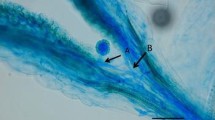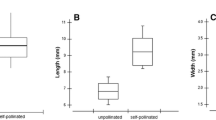Summary
Flowers of Pisum sativum plants grown in the field and greenhouse were self-pollinated and pollinated with Vicia faba. Germination of pollen and pollen tube growth were slower in the Pisum x Vicia cross. About 2% fertile ovules in the field and 8% in the greenhouse were obtained from the Pisum x Vicia cross, compared to 26% and 48% for Pisum x Pisum. Development of the Pisum x Vicia embryo was normal in form, though much slower than the Pisum x Pisum embryo, and about the sixth day it began to collapse. The greatest difference between the two types of crosses was observed in the endosperm. While the Pisum x Pisum endosperm nuclei divided normally and endosperm developed throughout the ovule cavity and around the embryo, the Pisum x Vicia endosperm nuclei formed only scattered masses of densely stained nuclei which were not always in close proximity to the hybrid embryo. It was concluded that faillure of some ovules to develop following Pisum sativum x Vicia faba cross pollination was the result of slow germination of pollen and slow growth of the Vicia pollen tubes, with subsequent lack of fertilization. Collapse of fertilized ovules was associated with abnormal and limited development of the hybrid endosperm, possibly leading to lack of nourishment and eventual collapse of the hybrid embryo.
Similar content being viewed by others
References
Brezhnev, D. D., 1962. Wide hybridization in vegetable breeding. In: N.V.Tsitsin (Ed.), Wide hybridization of plants. (translated from Russian). Nat. Sci. Found., Washington, D.C.
Brink, R. A. & D. C. Cooper, 1939. Somatoplastic sterility in Medicago sativa. Science 90: 545–546.
Brink, R. A. & D. C. Cooper, 1947. The endosperm in seed development. Bot. Rev. 13: 423–451.
Buchholtz, Y. T., 1931. The dissection, staining and mounting of styles in the study of pollen tube distribution. Stain. Tech. 6: 13–24.
Cooper, D. C., 1938. Embryology of Pisum sativum. Bot. Gazette 100: 123–132.
Cooper, D. C. & R. A. Brink, 1940. Somatoplastic sterility as a cause of seed failure after interspecific hybridization. Genetics 25: 593–617.
Couper, R. L., 1959. Hybridization in Vicia. Agron. Abstr. 56.
Donnelly, E. D. & E. M. Clark, 1962. Hybridization in the genus Vicia. Crop Sci. 2: 141–145.
Gritton, E. T., 1969. Crosses between Pisum and closely related genera. The Pisum Newsletter 1: 7.
Guignard, L., 1881. Recherches d'embryoge végétale comparée. 1. Legumineuses. Ann. Sci. Nat. Bot. VI. 12: 5–166.
Hakansson, A. & A. Ellerstrom, 1950. Seed development after reciprocal crosses between diploid and tetraploid rye. Hereditas 36: 256–296.
Kapoor, B. M., 1966. Contribution to the cytology of endosperm in angiosperms. XII. Pisum sativum L. Genetica 37: 557–568.
Kapoor, B. M. & S. L. Tandon, 1964. Contributions to the cytology of endosperm in some angiosperms. VII. Vicia faba L. Caryologia 17: 471–479.
Kihara, H. & Y. Nishiyama, 1932. Differential compatibility in reciprocal crosses of Avena with special reference to tetraploid hybrids between hexaploid and diploid species. Japan. J. Botany 6: 245–305.
Kraus, E. J., 1915. The self-sterility problem. J. Heredity 6: 549–557.
Leewrik, D. M. & F. C. Elliot, 1965. An allotetraploid from the interspecific cross Vicia sativa L. x Vicia angustifolia L. Mich. State Univ. Agr. Exp. Sta. Quart. Bull. 47 (4): 486–491.
Linck, A. J., 1961. The morphological development of the fruit of Pisum sativum, var. Alaska. Phytomorphology 11: 79–84.
MettinDietervon, 1960. Über das Wesen des angeblichen Linsen-Wicken-Bastards. Biologisches Zentralblatt 79: 701–718. (In German, English summary).
Satina, S., J. Rappaport & A. F. Blakeslee, 1950. Ovular tumors connected with incompatible crosses in Datura. Amer. J. Bot. 37: 576–586.
Soueges, E. C. R., 1948. Embryogénie végétale. Embryogénie des Papillionacées. Developpement de l'embryon chez le Vicia faba L. (Foba vulgaris Moench). C. R. Acad. Sci., Paris 226: 2101–2103.
Sveschnikova, E. N., 1940. Cytogenetical analysis of heterosis in hybrids of Vicia. J. Heredity 31: 349–360.
Thompson, W. P. & JohnstonDorothy, 1945. The cause of incompatibility between barley and rye. Can. J. Res., Sect. C. 23: 1–15.
Author information
Authors and Affiliations
Rights and permissions
About this article
Cite this article
Gritton, E.T., Wierzbicka, B. An embryological study of a Pisum sativum x Vicia faba cross. Euphytica 24, 277–284 (1975). https://doi.org/10.1007/BF00147200
Received:
Issue Date:
DOI: https://doi.org/10.1007/BF00147200




